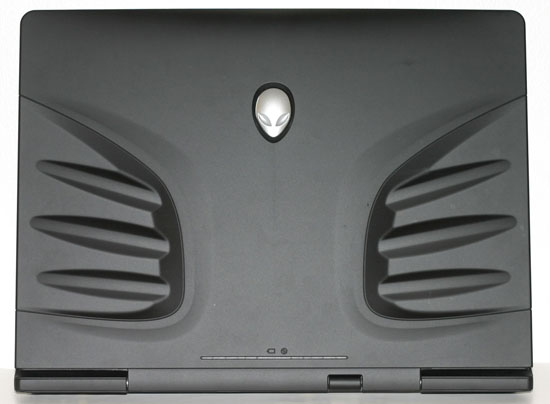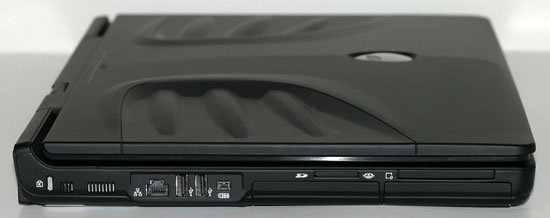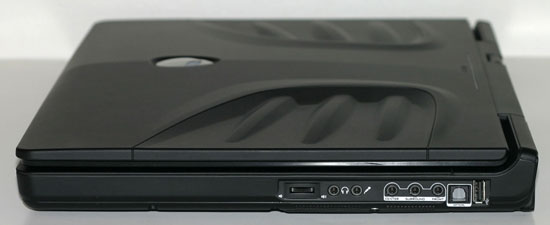Alienware Area-51 m9750: Power Gaming on the Go
by Jarred Walton on August 24, 2007 8:00 AM EST- Posted in
- Laptops
Design and Appearance
Alienware isn't just about performance; they're about making a statement as a computer owner. Walk into a room with an Alienware PC, and you will be hard-pressed not to notice it. The same can be said of the Alienware Area-51 m9750. If you're looking for a laptop that stands out from the crowd, in performance as well as appearance, there's no question that this laptop is eye-catching.
The exterior of the m9750 is a matte black finish - don't mind the picture, as the flash makes it look lighter in appearance; this is a dark black laptop that almost seems like it absorbs light. If the Men in Black carried around notebooks, they would probably look something like this. You also get Alienware's signature gray headed alien face centered in the top panel, and for added flair the eyes glow blue when the system is powered on. As a business notebook, this is almost certainly too over-the-top for most companies - unless of course you work for some gaming company in which case it would likely fit right in the surroundings. About the only complaint we have with the top of the notebook is that it's not perfectly flat, and you wouldn't want to set anything on top of the top panel - not that you really should do that anyway.
Because of the way the notebook is put together and the extra features on tap, the location of various features is somewhat different than what we're used to seeing on notebooks. The optical drive is located in the front center portion of the notebook. Speakers are located to the left and right, and they actually provide pretty good audio quality. In fact, these are probably the best sounding notebook speakers we've ever used - not that that's really saying a whole lot.
The back of the notebook has a variety of external connections as well, some typical and others less so. Alienware provides a full complement of video connections: DVI, VGA, S-Video, and component outputs are all present. On the left you also get the optional TV input, a modem jack, and an audio in port. In the center of the rear side is the power input along with a USB port. Two large exhaust ports take up the remainder of the rear side.
The left side has a couple USB ports, a mini FireWire port, the Ethernet jack, an ExpressCard/54 expansion slot, and a 4-in-1 flash memory reader (SD/MS/MSPRO/MMC). Towards the back of the notebook are a Kensington lock and a few air intake slots. The left side also houses the two 2.5" hard drive bays.
The right side of the notebook is primarily dedicated to audio functions, although there's also a USB port at the back. Alienware includes an S/PDIF optical out jack, along with five analog audio jacks (plus the one on the rear), enabling full surround sound. They also include a volume control that's an analog style "wheel", although the actual volume adjustment is still digital in nature. For quick adjustment of application volumes, we found this approach to be far more useful than some of the other volume controls we've seen on laptops. However, there were a few occasions (certain games) where the volume knob wouldn't work until we exited to the desktop. We've seen that with other laptops, and it appears to be an issue with certain games taking control of the Windows audio stack.
Alienware isn't just about performance; they're about making a statement as a computer owner. Walk into a room with an Alienware PC, and you will be hard-pressed not to notice it. The same can be said of the Alienware Area-51 m9750. If you're looking for a laptop that stands out from the crowd, in performance as well as appearance, there's no question that this laptop is eye-catching.
 |
The exterior of the m9750 is a matte black finish - don't mind the picture, as the flash makes it look lighter in appearance; this is a dark black laptop that almost seems like it absorbs light. If the Men in Black carried around notebooks, they would probably look something like this. You also get Alienware's signature gray headed alien face centered in the top panel, and for added flair the eyes glow blue when the system is powered on. As a business notebook, this is almost certainly too over-the-top for most companies - unless of course you work for some gaming company in which case it would likely fit right in the surroundings. About the only complaint we have with the top of the notebook is that it's not perfectly flat, and you wouldn't want to set anything on top of the top panel - not that you really should do that anyway.
 |
Because of the way the notebook is put together and the extra features on tap, the location of various features is somewhat different than what we're used to seeing on notebooks. The optical drive is located in the front center portion of the notebook. Speakers are located to the left and right, and they actually provide pretty good audio quality. In fact, these are probably the best sounding notebook speakers we've ever used - not that that's really saying a whole lot.
 |
The back of the notebook has a variety of external connections as well, some typical and others less so. Alienware provides a full complement of video connections: DVI, VGA, S-Video, and component outputs are all present. On the left you also get the optional TV input, a modem jack, and an audio in port. In the center of the rear side is the power input along with a USB port. Two large exhaust ports take up the remainder of the rear side.
 |
The left side has a couple USB ports, a mini FireWire port, the Ethernet jack, an ExpressCard/54 expansion slot, and a 4-in-1 flash memory reader (SD/MS/MSPRO/MMC). Towards the back of the notebook are a Kensington lock and a few air intake slots. The left side also houses the two 2.5" hard drive bays.
 |
The right side of the notebook is primarily dedicated to audio functions, although there's also a USB port at the back. Alienware includes an S/PDIF optical out jack, along with five analog audio jacks (plus the one on the rear), enabling full surround sound. They also include a volume control that's an analog style "wheel", although the actual volume adjustment is still digital in nature. For quick adjustment of application volumes, we found this approach to be far more useful than some of the other volume controls we've seen on laptops. However, there were a few occasions (certain games) where the volume knob wouldn't work until we exited to the desktop. We've seen that with other laptops, and it appears to be an issue with certain games taking control of the Windows audio stack.










26 Comments
View All Comments
Guspaz - Saturday, September 1, 2007 - link
Anybody considering buying a gaming notebook should refuse to purchase one until nVidia gets their act together and starts releasing notebook drivers with regularity.I myself am a notebook gamer, with a modest Dell Inspiron 9400, Core 2 Duo 2.16GHz, and aGeForce Go 7900gs. I run Vista.
Well, nVidia currently DOES NOT OFFER Vista notebook drivers at all. Not a one, nada. Your only options are to either use Dell's driver, which is an ancient beta missing support for most features of the GPU, or a hacked desktop driver (which still is missing many features under Vista, and lacks PowerMizer support).
Under XP, the situation isn't much better. nVidia's latest notebook drivers for XP are 84.63, released over a year ago on July 5, 2006.
Your notebook manufacturer MIGHT provide newer drivers, if you're LUCKY. For Dell's part, their XP drivers are still ancient and stuck in the 90 series, and they only ever released ONE driver for Vista, probably thinking "Well, they have drivers now, that's good enough."
In order to play BioShock on a notebook, you have NO other option but to hack the desktop drivers.
This is NOT an acceptable situation. As notebook gamers, we should REQUIRE nVidia to SUPPORT THEIR PRODUCT and release regular updates for their cards. The fact that their desktop drivers work so well on notebooks with a simple INF tweak should show you how EASY it would be for them to release official notebook drivers. They give us this bullshit story about how driver updates need to come from the notebook manufacturers due to differences between notebooks. This is bullshit. I don't get my desktop graphics drivers from Abit because they happen to have made the motherboard.
So what do I plan to do? I have no choice. I'll keep using hacked desktop drivers for lack of ANY other option.
monitorjbl - Saturday, August 25, 2007 - link
Yay, a William Gibson reference!
JarredWalton - Saturday, August 25, 2007 - link
Bonus points if you actually played the old Neuromancer game by Interplay. Cue Devo...Some
Things
Ne-ver
Change
....
:)
strafejumper - Friday, August 24, 2007 - link
i never understood the concept of all these laptops such as this alienwarethe idea of a laptop to me is it is portable
however if the battery only last 60 mins it is not really that portable
for $5000 i would want to be able to for example watch a dvd
however this cannot even do that seemingly simple task!
battery life to me is so much more useful than the extra cpu and gpu cycles
when watching a dvd, browsing the internet, playing cards, backgammon, chess or other simple games, listening to music, typing documents, emailing, messengering etc. etc. the extra horsepower of the cpu and gpu are not even being used.
battery life > some extra frames in the latest game (which is better on a desktop probably anyway with bigger screen, full keyboard + mouse, desk, speakers, etc.)
Inkjammer - Saturday, August 25, 2007 - link
I am one of the people who have bought, buy and will buy workstations like these. People like me don't buy them as a "laptop" but as a "portable desktop replacement" (DTR).Some of the justifications:
Lugging an entire system to LAN parties can be frustrating, especially since I have a 24" monitor, large keyboard. I'm also using a Coolermaster 830 CM Stacker case, which weighs a ton, and breaking it down, setting it up can take far, far too long.
I also tend to take my DTR notebooks systems with me to work, where I can game during nightshifts. I'm also stationed overseas, so being able to easily transport a FULL system, even if contains in a laptop, is invaluable. I also do high end art and 3D animation, and need the additional power for job and hobby.
The tradeoff for portability and battery life on a notebook is fairly steep, but there's not much in the way of compromise.
And yes, I have a second laptop for my "on the go" needs.
yyrkoon - Friday, August 24, 2007 - link
Some people do not have room for a desktop(or a desk), and use nothing but laptops. Others may travel, staying in hotels nightly, having a plug available, but do not want to tote around a desktop with them. Other people like truckers may be able to use an AC inverter for power, but have limited room in their sleepers for a computer.Having said that, I have been a trucker, and kept a full sized desktop in my sleeper, and I have also worked over the road, staying in a hotel nightly, and used a desktop during this time as well. Not everyone is like me however, and some of these people may preffer something smaller, and easier to carry around, or maybe just smaller to maximize their given 'alotted space' where ever they may be. I wouldnt buy one though . . .
wolfman3k5 - Saturday, August 25, 2007 - link
Well, how about there east bound, you got your ears on? I totally know what you mean, how ever I never had time for gaming. Battery life was always more important to me. I'm also an ex trucker, God, it's a lonely job. Anyway, just wanted to say hi:)yyrkoon - Monday, August 27, 2007 - link
Myself, for 2 years(and around 200k miles) I would typically drive 8HRs/day, 2-3 months at a time. Plenty of down time, and plenty of time to game, even in the early to mid 90's ;) Of course back then, there was nothing like this availible, and I was probably one of the first drivers to have a full blown desktop in their cab(IMB compatable 386SX-25 with 4 MB of ram YEEE HAAW!) lol . . .yyrkoon - Monday, August 27, 2007 - link
IBM compatable . . .JarredWalton - Monday, August 27, 2007 - link
IBM compatible you mean? :)